By Dominik Pudo and Jake Galuga
 Dominik Pudo and Jake Galuga contend that after decades of research and ‘rescoping,’ high energy laser (HEL) weapons are making their irreversible transition onto the battlefield. To provide an insight into how this has happened and what it might mean, Pudo and Galuga here examine 1) how a shift away from the strategic use of HELs and towards their tactical application could allow for the exploration of this technology at a fraction of past costs; 2) the advantages and disadvantages of using HELs in military operations, and more.
Dominik Pudo and Jake Galuga contend that after decades of research and ‘rescoping,’ high energy laser (HEL) weapons are making their irreversible transition onto the battlefield. To provide an insight into how this has happened and what it might mean, Pudo and Galuga here examine 1) how a shift away from the strategic use of HELs and towards their tactical application could allow for the exploration of this technology at a fraction of past costs; 2) the advantages and disadvantages of using HELs in military operations, and more.
Historical Perspective
From the dawn of military warfare history, nearly every weapon relied upon a rapid transfer of destructive energy onto a target,1 with an ‘intermediate’ consisting of a physical projectile. Technological progress then allowed for the delivery method to evolve from direct hits to ballistic trajectories and propulsion-driven flight, while the kinetic (the speed of the projectile multiplied by its mass) energy delivered on target got augmented by the chemical energy released from explosive warheads. The basic physical paradigm remained unchanged. However, even the sophistication of modern military platforms and missiles do not preclude the fact that the underlying mechanism of neutralization is still based upon a physical projectile which has to reach its objective.2
It was the invention of the laser in the early-1960s3 that stemmed a vision of a breakthrough approach – that of a directed energy weapon,4obliterating targets by the means of an instantaneous linear energy beam. Although successful in a limited number of demonstrations, early lasers able to generate sufficient powers so as to damage a target at the required range were both extremely complex and suffering from a large footprint. Known as chemical high energy lasers5 (HELs), as the process used to generate the laser beam was an exothermic reaction between chemical substances, the systems inherently bore a resemblance to rocket engines – augmented by the addition of state-of-the art fragile optics inside, testifying to their complexity. Work on these Megawatt-class systems nevertheless continued, driven by their envisioned employment paradigm as point defence systems against missiles, the primary threat of interest during the Cold War era. Despite tremendous engineering challenges, they matured into a number of successful, if not incredible military demonstrators, among which were the Tactical High Energy Laser6 (THEL) and the Airborne Laser Laboratory7 (ABL), on board a modified Boeing 747 platform.
At their apex, these chemical laser projects spearheaded two fundamental contributions to the development of directed energy weapons. First, they pioneered a vast array of scientific and engineering advances, resulting in the ability to manufacture complex optical systems of quality and power levels unseen before, in addition to their capacity to operate in harsh environments. Second, despite their complexity and issues, they were a proof of concept that directed energy can effectively neutralize relevant military targets at operational ranges.
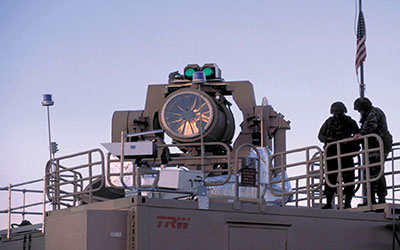 Notwithstanding their achievements, chemical lasers suffered from three major flaws, which contributed to their demise prior to a sustained transition into the armed forces. First, they were often delivered too late and at too great a cost. Program delays, combined with cost overruns due to inherent issues in tackling what was basically an unexplored technological frontier, led to system demonstrations occurring sometimes a decade after what was initially planned. It can be argued that such delays are intrinsic to most complex weapon systems development. However, the case for chemical HELs was further challenged by the change in the geo-political and global military context, along with the continuous development of traditional weapon systems. Increasing budgetary pressure, a diminishing Soviet-era missile threat to the continental United States, the shift towards asymmetrical warfare since 9/11, and the advances in conventional missile defence systems, made expensive, point-defence HEL endeavours increasingly difficult to justify. The technology itself was also handicapped by the complexity of the laser systems themselves, along with a cumbersome logistics trail made necessary by the supply as well as the disposal of highly toxic chemical fuels and by-products. The decision to terminate the ABL8 then became somewhat of a symbol of a fabulous military and scientific defence achievement which simply came too late, with too high a price tag.
Notwithstanding their achievements, chemical lasers suffered from three major flaws, which contributed to their demise prior to a sustained transition into the armed forces. First, they were often delivered too late and at too great a cost. Program delays, combined with cost overruns due to inherent issues in tackling what was basically an unexplored technological frontier, led to system demonstrations occurring sometimes a decade after what was initially planned. It can be argued that such delays are intrinsic to most complex weapon systems development. However, the case for chemical HELs was further challenged by the change in the geo-political and global military context, along with the continuous development of traditional weapon systems. Increasing budgetary pressure, a diminishing Soviet-era missile threat to the continental United States, the shift towards asymmetrical warfare since 9/11, and the advances in conventional missile defence systems, made expensive, point-defence HEL endeavours increasingly difficult to justify. The technology itself was also handicapped by the complexity of the laser systems themselves, along with a cumbersome logistics trail made necessary by the supply as well as the disposal of highly toxic chemical fuels and by-products. The decision to terminate the ABL8 then became somewhat of a symbol of a fabulous military and scientific defence achievement which simply came too late, with too high a price tag.
Airborne Laser Laboratory. US Missile Defense Agency/Wikimedia Commons.
With the beginning of the 21st Century, a novel approach for high energy laser weapon systems emerged, relying upon solid-state lasers,9,10 driven in part by industrial applications for welding and material processing. These inherently-simple and robust lasers, requiring no other fuel than an electrical power supply, initially suffered from what was seen as a major flaw: their output powers, in the kW range, are a fraction of what their older chemical counterparts were able to achieve. The technology, nevertheless, attracted significant attention, as it promised to singlehandedly eliminate a major logistical handicap associated with chemical lasers. In addition, kW power levels forced a major paradigm shift in the anticipated use of HELs for defence applications, with the focus shifting away from strategic and going towards tactical applications with specific, more limited mission scopes. Turning the page away from ambitious HEL endeavours,11 which aimed at affecting the balance of power against the Soviet Union, the new approach led to the birth of lower risk and lower cost programs, supported by an increasing number of high level strategic and budgetary assessments.12,13,14,15 A number of successful demonstrators followed, either neutralizing explosive devices, such as with the U.S. Zeus16 and Israeli Thor17 systems, or incoming mortar rounds and unmanned aerial vehicles (U.S. HEL Mobile Demonstrator).18,19
As of 2016, with Israel operating their Thor II system, and the U.S. Navy being given official permission to use the AN/SEQ-3 (LaWS) on board the USS Ponce,20 electrically-powered lasers have henceforth started their transition into a regular, if not inevitable technological component of modern warfare. The focus of the U.S. defence community is now upon rapidly operationalizing HELs, with a strong support from senior military leadership across all services. The laser systems produced now are modern and mature technologies that can be employed at the tactical level to gain an operational advantage.
Perception, Reality, and Lethality
Notwithstanding their actual properties, directed energy weapons have long suffered from a somewhat inaccurate portrayal, driven by their representation in media and literature. Well before the advent of Star Wars, the exaggerated depiction started with H. G. Wells’ The War of the Worlds, published as far back as 1898, and depicting death rays obliterating any target in their path. Subsequently glamourized by a plethora of special effects emanating from movie studios, HELs gained an aura of extremely powerful weapons, with visible beams annihilating every target in a spectacular explosion, not to mention the accompanying symphony of sound effects. While such representation was shunned by subject matter experts, decades of exposure to such an exaggerated if not flawed image of a technology shaped to some extent the perceptions of, and expectations related to HELs.
Within this context, it is therefore useful to look at some of the most basic properties of a HEL weapon system so as to understand its strengths and flaws, as compared to traditional, kinetic systems. Notwithstanding the underlying technology, a continuous-wave HEL beam is nothing more than a focused ray of – most often invisible to the naked eye – optical radiation, which simply delivers heat to the surface of a target. That in itself leads to three fundamental properties of a HEL: First, the system is line-of-sight, requiring good visibility of the target; secondly, the time of flight is effectively nil; and finally, it delivers only thermal energy on a target’s surface over a non-negligible time scale. In stark contrast with kinetic weapons, there is henceforth no momentum transfer, no shock wave, no high velocity fragments, and generally no instantaneous effects. The energy deposited on target is usually cumulative over a few, to tens of seconds. (For the sake of accuracy, it is worth noting that, in some cases, a HEL does induce complex secondary effects, such as surface plasma, localized shockwaves, and others.)
At the very basic level, the anticipated lethality of a HEL weapon system is thus reduced to whether the target of interest can be neutralized by (over)heating a small area on its surface, as if it were exposed to a blowtorch flame. It then becomes intuitively easy to list a few sensitive target types, such as explosive devices, where the main charge or the detonator is easily ignited by heat, or control surfaces of aerial vehicles, often fragile and flammable. Unsurprisingly, optical sensors and cameras are also inherently sensitive to optical radiation. Conversely, a system surrounded by layers of insulating, inflammable, and high melting point material is all but immune to surface heating – whether by a laser or a flame. In such a case, a kinetic weapon does, and will remain the best approach.
Features, Benefits, and Drawbacks
While early discrimination of targets with low vulnerability to a laser narrows down the likely (and realistic) applications of HELs, four key features of lasers can lead to direct operational and tactical benefits. First, HELs operate at a nearly nil cost-per-shot basis, since the financial burden of an engagement can be reduced to the cost of operating the generator which provides the required current. Second, they benefit from a nearly-unlimited magazine depth, as they can continuously operate as long as their power supply is fueled. Third, the time-of-flight of a laser beam is instantaneous, which leaves the targeted system with no room to avoid a first strike. Finally, HELs, by design, can be used at lower power levels than their rated maximum, thus allowing the effects on target to be tailored to the mission and constraints. It nevertheless goes without saying that these features ought to always be considered in the context of a specific scenario and mission objectives to assess their actual benefit. As stated earlier, for an array of applications, kinetic weapons will remain the tool of choice for the simple reason that they deliver an explosive warhead, as opposed to only heat.
A better assessment of the high-level impact of acquisition and deployment of HEL defence systems is also gained when examining the strategic impact of each of the aforementioned properties. The minimal cost-per-shot argument becomes of paramount importance in conflicts where the opponent’s objective is not only military, but economic. Modern defence systems, costing over a million dollars per shot for a surface-to-air missile, such as the RIM-162 evolved Sea Sparrow, or the MIM-104 Patriot, can rapidly inflict a non-negligible financial dent when used in significant numbers – a hindrance, especially against low-cost threats. This discrepancy between the cost of the incoming threat and that of the countermeasure is a prominent, and rising element of asymmetrical warfare, on land (IEDs vs. land platforms), in the air (home-made rockets against urban areas), and on the sea (mortar launches against surface vessels). It is worth noting that the economic aspect is becoming arguably one of the key arguments behind the announcement of the Iron Beam in Israel, a HEL-based defence system against short range rockets, mortars, and artillery.
The lack of a ‘logistics tail’ associated with munitions also has an impact upon the complexity of military operations involving HELs. While of lesser importance in a domestic context, or in the proximity of supplies, the ability of a nation to conduct (and afford) deployed operations is affected by the effectiveness of its logistics chain. The concept of weapon systems with reduced maintenance and spare parts requirements and no ammunition relieves the supply burden which can then be redirected towards other needs and consumables. As a result, it contributes to more agile, more autonomous, and more flexible armed forces. One context in which this has been a major argument for HEL systems is that of surface naval platforms, which have limited storage space, and carry increasingly less of the increasingly expensive countermeasure systems; not to mention, the inherent difficulties in re-supplying. Seeing the potential of HELs, the U.S. Navy recently fielded their AN/SEQ-3 high energy laser system on board the USS Ponce.
AN/SEQ-3 laser system on board USS Ponce. U.S. Navy/John F. Williams
Last but not least, the ability of a scalable effect on target is a novel, and henceforth arguably yet unexplored concept in weapon systems. Indeed, kinetic weapons function under the ‘hit-or-miss premise,’ where a warning shot in which the projectile deliberately misses the target yet remains close enough to be noticed, is the only way to deliver a scaled-down message. Lasers, on the other hand, can operate at any power level up to their rated maximum, which, in specific circumstances, allows tailoring the desired effect. A HEL system designed for a hard kill of aerial threats could still be used to temporarily dazzle or fry the camera on board a UAV, or an aircraft performing a hostile overfly, without inflicting any kinetic damage. The ability to undertake such action could have a major impact insofar as avoiding excessive escalation of force in politically delicate circumstances and providing a commander a wider choice of direct action from a single weapon system. Finally, the availability of a continuous range of power levels from a laser is also tied to their reliability – they tend to suffer from a ‘graceful degradation’ of output powers, instead of catastrophic failures.
Issues, Challenges, and Lessons Learned
Nevertheless, the same physical properties of HELs that translate into the aforementioned advantages bring their share of limitations. As mentioned earlier, HEL lethality is only driven by localized surface deposition of heat, which renders them ineffective against a number of target types. The amount of energy delivered on target even by state-of-the-art HELs is currently orders of magnitude smaller than that by conventional weapons. While a 100 kW laser delivers 100 kJ per second of dwell time, one kg of TNT equivalent yields 47 times more energy over a fraction of a second. The requirement for sustained firing over seconds also limits their use against fast-moving objects. The physics of atmospheric propagation add an additional challenge for long-range applications insofar as the beam undergoes distortions, which reduces the irradiance (power per surface area) on target. These are further aggravated in adverse atmospheric conditions, although advances in beam control and laser sources at different wavelengths allow some of the issues to be circumvented. While weather will remain a challenge for HELs in the foreseeable future, the military could nevertheless rely upon backup kinetic weapon systems when necessary.
One particular aspect pertaining to the use of HELs is that of laser safety. With intra-beam irradiances orders of magnitude above laser safety limits, the risk of reflections in the vicinity of the target, and the perception of an ‘infinite’ reach of the laser beam, there has been an understandable mistrust pertaining to the safety aspects of such weapons. It was further exacerbated by the psychological impact of invisible and silent beams, as well as by industry-driven laser safety standards which employ a deterministic, zero-risk exposure approach. Recently however, the consideration of HEL laser safety has resulted in significant advances on many levels. Risk assessment is shifting from being deterministic to probabilistic, where not only the possible laser irradiance, but also the risk of exposure is taken into account. As such, it brings HEL safety assessments at par with the approach governing transportation safety, satellite collision with debris, or nuclear weapons. In parallel, the hazards associated with a HEL beam affecting airspace or space assets are being alleviated through the development of systems which prevent the beam from firing into specific azimuth and elevation coordinates. The hazards pertaining to reflections from the target are being addressed by exhaustive research, experimentation, and modelling efforts – not unlike what was once done to determine safety ranges for explosives. Finally, development efforts are already under way towards the next generation of laser sources, operating at much safer wavelengths.
As with any weapon system, the final balance between the advantages and drawbacks is ultimately determined by the specific mission requirements. Nevertheless, despite being a viable solution in a number of scenarios, and despite their technological maturity, the fielding of HELs has been repeatedly ‘grinding to a halt’ at the demonstrator level over the past decades. A number of issues have been identified as possible root causes for what is colloquially called the ‘valley of death’ in between a successful demonstrator, and a subsequently-approved acquisition project:
Overpromising and underdelivering. Over decades of HEL defence programs, there has been a cycle of setting excessively ambitious expectations for political and financial support, followed by inevitable delays and underperforming deliverables. Although part of the risk in setting the goals stemmed from the fact that these were truly scientifically challenging and novel endeavours, there was also at times an arguably-excessive push for ‘the technology for the sake of the technology.’ That approach acted as a double-edged sword: while managing to secure support and raising expectations, it inevitably led to subsequent scepticism once delays and cost overruns became apparent. Avoiding such pitfalls thus requires a more realistic if not humble mission-specific expectation-management approach from the start, without ever neglecting the limitations of laser systems.
The ‘behind-the-corner’ syndrome. As opposed to their kinetic counterparts, laser technologies undergo a more continuous development process. Nearly every year brings incremental improvements in laser diodes, materials, semi-conductors and other sub-components, which increase the power, and efficiency of a system, coupled with a size and weight reduction. As a result, it becomes difficult to freeze the technical specifications to start the acquisition process, while knowing that improved products are constantly becoming available. Furthermore, since each enhancement in the technology expands the mission envelope of a system, manufacturers are under a temptation to push a more-and-more capable solution at the expense of a small delay. Consequently, an early and firm definition of the mission envelope for which the HEL is being acquired would allow freezing the specifications, and also accelerate procurement.
Technology-driven approach. In parallel to the ‘behind-the-corner’ syndrome, the debates and arguments over early HEL systems sometimes suffered from being excessively centered upon the technology and parameters, as opposed to mission requirements. Despite the fact that from both the military operator’s and the decision-maker’s perspective, the laser power, or the underlying technology, remains nearly irrelevant, it has been too often used as the spearheading sales argument. Since this has recently been the trend, HEL systems thus need to be addressed either from the weapons’ performance level (engagement range, target lethality, etc.), or from the tactical planning (mission, logistics, and kill probability) perspectives.
The Business Case
While early ambitious HEL defence programs, such as the ABL, required investments well into billions of dollars, the emergence of kW-class electrically-powered lasers opened up an opportunity to explore this technology for defence applications at a fraction of past costs. With allied countries having borne the burden of high-risk technology research over the past decades, and having recently turned their attention towards tactical-level employment HELs with a number of demonstrators, there is now arguably a significant potential to leverage on the current level of R&D at lower cost and with lower risks.
Existence of low cost, high technological readiness level (TRL) technologies: The underlying technology for HELs with an output power into the 10s of kW is both commercially available, and already used in a number of military system demonstrators. In parallel, lasers can, to a certain extent, be ‘piggybacked’ to existing targeting and tracking systems. As a result, new HEL defence programs and projects can leverage existing products, thus minimizing the delays and cost overruns associated with the development of emerging technologies.
Emerging threats and narrowed-down mission scope: The rising complexity of modern defence systems ensures that asymmetric, low cost threats will continue to proliferate. At the same time, HELs have been increasingly proving themselves as serious contenders for specific missions: countering soft, short-range targets such as surface explosives, unmanned aerial vehicles, swarm boats, and sensors. As a result, there is now sufficient evidence to identify, with a high degree of confidence, applications where the HEL has the higher likelihood of being a practical – if not the best – tool.
Experience through deployment: While demonstrators are both useful and necessary in verifying the potential and threshold performance of military systems, no amount of controlled tests will replace the knowledge and experience gained through realistic trials of military systems, not to mention that gained through deployment and operational use. It is therefore increasingly argued that, given their technological maturity, long-term risk mitigation and short-term benefits would be best achieved by rapidly fielding simpler HEL systems, as opposed to delaying more ambitious programs. It has to be noted that this approach was recently endorsed by the U.S. Navy, which saw the deployment of a relatively low power laser on board one of its platforms as being the best option to both test and learn from the employment of naval HEL systems.
Conclusion
Regardless of their applications, it can be safely stated that after decades of research and ‘rescoping,’ high energy laser weapons have begun to make their irreversible transition onto the battlefield. Whether they will proliferate towards commonly-used systems, or settle in a niche for specific applications still remains open for discussion. However, their fielding as part of armed forces is now a matter of fact. Notably, this applies to the debate on high energy lasers and, more broadly, directed energy weapons expanded beyond the military circles, as testified by the increasing number of public reports originating from such sources as the Center for Strategic and Budgetary Assessment,21 or the Congressional Research Service.22 Within NATO, work has already started on the impact of, and interoperability considerations for the use of HELs in a shared battlespace.23 The Alliance thus acknowledged that such a scenario is likely to happen in the near-future – whether or not additional nations develop their own HEL programs. Therefore, it does not take a significant leap of faith to foresee that defence against HELs is to be addressed as well – which cannot be accomplished without a fundamental and thorough understanding of their underlying technology and lethality in the first place. Increasingly fast-paced research with respect to the development of novel laser systems will thus continue, complemented by an increasing control of atmospheric propagation and lethality on selected targets, potentially revealing unforeseen applications. At the same time, there is a rising need for a military-driven incorporation of HELs into doctrine, concepts of operations, techniques, tactics and procedures. This will prepare the armed forces both for the eventual use of HELs, or unavoidable interoperability with allied laser weapon systems. It is within this context that the increasing support and investment of the Canadian Army towards research and development efforts undertaken at the Defence Research and Development Canada (DRDC) will now quickly allow assessing HELs as viable options for specific missions of interest. The cross-service potential of this technology has also been recognized by the Royal Canadian Navy, which envisions it to be a possible component of its next generation surface platforms.
A-10 fires first-ever laser-guided rocket, 20 March 2013. DVIDS/Samuel King/Photo 899270
Notes
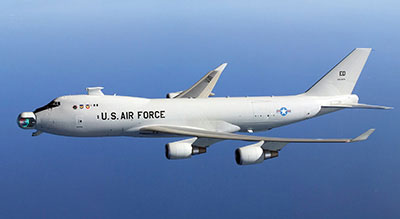
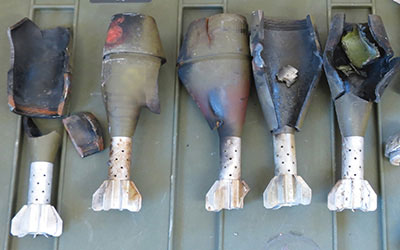
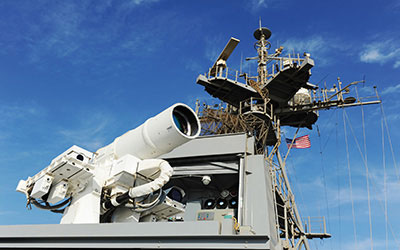
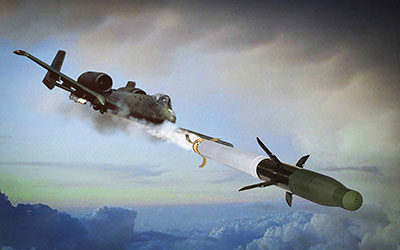
No comments:
Post a Comment